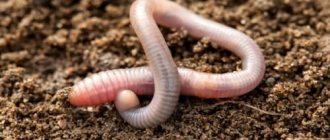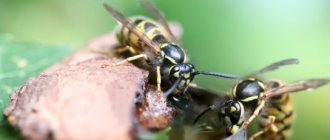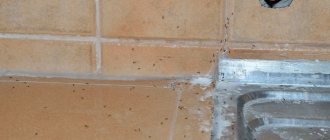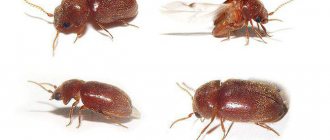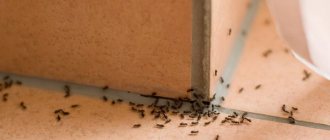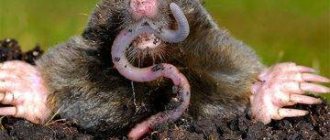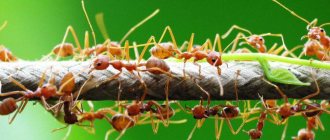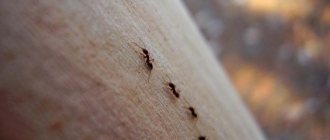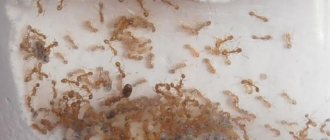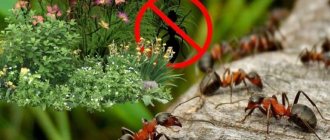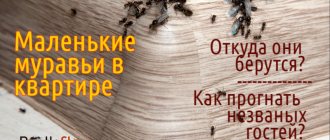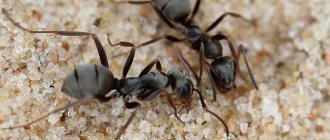A frequently asked question is the benefits and harms of ants in life and farming. Having seen ants on their property, some people rush to stock up on various preparations to kill them, while others do not pay attention to these insects, arguing that there are no problems on their part.
So what can you expect from ants - harm or benefit? This problem requires a solution.
Why are ants needed in the forest?
The status of the ant in relation to the forest is very high. Everyone knows from school that you should not destroy ants’ nests. These insects are protected by the state and are specially dispersed artificially to new places.
These insects are the most useful inhabitants of forests.
With their usefulness, they even earned the title “the ants of the forest.”
What benefits do ants bring to the forest? Ants that settle in dead wood accelerate its decomposition, thus freeing the forest from diseased specimens.
Ants are seed distributors of many plants. While collecting them and dragging them home, he loses some along the way. This is how plants reproduce throughout the forest area.
Like bees, ants are pollinators for flowers, eating sweet nectar.
By building their underground houses and making numerous passages for their movement, they help loosen the soil. That is why forest plants living above anthills develop most actively. At the same time, in addition to breathability, the soil becomes more nutritious, enriched with organic matter and minerals.
Ants are beneficial insects for songbirds. They take them internally and externally. An ant shower helps birds get rid of parasites. While swimming in anthills, birds tuck insects under their wings and crush them on their feathers.
The benefits of ants in wildlife
First, you need to figure out what these little workers are needed for and what benefits they bring. Tiny hard workers are true forest orderlies. They lead a predatory lifestyle and are able to control the growth of the population of numerous parasites.
- The role of ants as an element of the food chain cannot be underestimated. They are the main source of food for anteaters, moles, and frogs. Carbohydrate-rich foods appeal to bears, many species of birds, lizards, shrews and many others.
- By using plant seeds as food, ants help them spread over large areas. As a result, the number of representatives of the plant world near the anthill increases.
- The benefit of ants in nature is that they actively protect plants from attacks by caterpillars and silkworms. Without the help of small workers, many plants would not have the opportunity to fully develop.
Interesting!
A colony that lives in one average anthill can consume more than 15 thousand different insects per day.
Ants in nature
Another key role of forest workers is to improve soil health. Each insect nest is a complex system in which there are numerous passages, tunnels and even communications. After the ants work in the ground, more air, heat and loop substances begin to flow to the roots of the plants. Unlike earthworms, ants are able to cultivate soil up to 1.5 meters. Worms live only at a depth not exceeding 20 m.
Question answer
What do ants eat?
Expert opinionEvgeniy Igorevich BraginSpecialist entomologist, 19 years of scientific experience.
Initially, the ant body needs carbohydrates to obtain energy and proteins for the growth of young individuals. They obtain the first of the nutrients from the juice of plants, fruits, and sweet honeydew of aphids, while the second is from insect carrion, which becomes an integral component of the diet during the feeding period of the larvae. They are also interested in human food. Representatives of some species feed their offspring with mushrooms.
Extraction of carbohydrates from berries
Are ants beneficial in the house?
Expert opinionEvgeniy Igorevich BraginSpecialist entomologist, 19 years of scientific experience.
Arthropods must exist in their natural environment; here they are beneficial and perform exceptional functions. However, in artificial conditions, significant harm from ants is observed. Insects set up diffuse nests, which complicates the fight against them, and also destroy food, spread bacteria and microbes on their legs, and contribute to the contamination of food in a person’s home. Harmful arthropods pollute the surrounding space - they carry waste products and rubbish from their nests to the outside.
Ants in the house do more harm than good
What is more from an ant - harm or benefit?
Expert opinionEvgeniy Igorevich BraginSpecialist entomologist, 19 years of scientific experience.
If we consider the option of insects living in natural conditions, we can say that they are very useful. However, the appearance of an anthill in a person’s home means the occurrence of many negative consequences. This means that the degree of benefit must be assessed taking into account the conditions.
The result of ants appearing in the house
Do ants fight pests?
Expert opinionEvgeniy Igorevich BraginSpecialist entomologist, 19 years of scientific experience.
Why are ants useful in the garden?
Despite some harm caused by insects in the garden, they also have a number of positive properties.
They build their anthills at a depth of one and a half meters, thereby loosening the ground. The soil is mixed at a depth of up to 70 centimeters, raising particles from the lower layers to the surface. At the same time, the soil becomes loose, therefore, it allows air and moisture to pass through better. Plant roots receive more nutrition under these conditions.
Ants increase the nutritional value of the soil because their activity helps remove greenhouse gases from the soil. The soil treated with insects is enriched with minerals. The area above the anthill is ideal for growing all garden crops.
In the soil treated with them, the potassium content doubles, and the phosphorus content increases almost 10 times .
Insects actively destroy garden pests. Garden pests: caterpillars, worms, slugs are a real treat for them. Scientists have calculated that the inhabitants of one anthill destroy about two thousand garden pests and their larvae in just one day of summer.
Description of the insect
There are quite a few differences between male, female and worker ants. During the mating season, the female and the male develop wings, which help them find each other for mating, but the working individuals do not. Separate parts of the body, which are separated by a narrow waist called a petiole, are the head and belly of ants. The body of insects is covered with a special exoskeleton. It is a durable chitinous shell that reliably protects the insect from possible damage. The so-called compound eyes have a complex structure, since they naturally have many small lenses.
In order to determine how illuminated a certain area is, there are three eyes, simple in structure, located on the top of the insect’s head. There are also antennae - with their help the ant detects vibrations, the presence of almost all chemicals and air flows. The antennae can receive and also perfectly transmit various signals. The upper jaws, also known as mandibles, are well developed. They are responsible for the construction and protection of housing, help deliver food, and so on. Each paw has a hook-shaped claw. Thanks to such claws, insects easily move along vertical surfaces.
Inside the abdomen there are internal organs and glands. The abdomen of working specimens ends with a sting. It is required for defense, attacking enemies and obtaining food.
Treatment
The healing properties of ants have been known for a long time. From time immemorial, people have made tinctures and ointments from them. These insects are still used today. The main active ingredient in such preparations is formic acid.
Acid-based drugs help in the treatment of arthritis, rheumatic and atrophic, neuroses, dizziness in old age. They can also alleviate the condition of patients with hepatitis.
Preparations with a hemostatic effect are prepared from ants. Their venom also contains antibiotics that can fight fungal and bacterial infections, including staphylococci and streptococci.
Before you destroy these little workers on your plots, evaluate the benefits they bring.
Reproduction
Fertilized ant eggs produce females, and unfertilized ant eggs produce males. The mating flight of the queen of the red wood ant and the female of other species occurs once in a lifetime. During it, females receive from males a supply of sperm for life, which lasts on average 10 - 20 years. After fertilization, the female chews off the now unnecessary wings, makes a chamber in a secluded place and places a nest there.
Gradually the anthill expands and the number of individuals increases. Ant eggs are oval in shape and very elongated, quite large. Their shell is translucent and milky white in color. The larvae look like worms. They move little; each feeds on worker ants, which also provide care for the offspring. The pupa looks like a large white or yellow egg. The appendages of an adult do not merge with the body, since they are located inside the cocoon.
Who will emerge from the cocoon in the end - a worker or a queen - will depend on what the pupa eats. Larvae consume protein foods, and adult insects consume carbohydrate foods. Who is protein? Insects and invertebrates that are collected by workers in the form of corpses or alive. Carbohydrate food is the secretions of sucking insects, that is, aphids, mealybugs, cicadas, and scale insects. Even adult individuals require plant juice, mushrooms, and crop seeds.
Working ants bring food to the forest anthill and distribute it evenly among family members. Working individuals, if necessary, drag the pupa to other chambers of the nest, later helping it leave the cocoon.
Varieties
Among the ants living in the forest there is a dangerous species - red or fire. Its adult representatives have a sting and poison, which contains the substance alkaloid solenopsin. These goosebumps are small - no more than 2 - 4 mm. Their antennae consist of 10 segments, ending in a club consisting of 2 segments. The home of red insects, that is, an anthill in the forest, is an earthen hill reaching a height of up to half a meter.
The most common species, the red ant, also lives in the forest. It has a large body size - from 4 to 9 mm.
The abdomen and back of the head are black, while the chest and the rest of the head are orange. This type of insect creates an anthill up to 2 meters in size from the ground and food debris. Females do not leave the nest in order to form new colonies in another place. They replace old queens after they die.
There is also a black-brown ant in the forest. The body size of females is 1 – 2 mm, workers range from 5 to 8 mm. The body is painted black and gray. Families of such insects are few in number. Females tend to move out and create separate colonies. Often the anthill is located under stones and looks like a low mound.
Hierarchy and structure of the anthill
Most species of ants live in large families, the number of individuals in which can reach 1-2 million. An integral part of the colony is the queen, which differs from worker insects in its larger size and relatively low mobility. The main function of the queen (queen) is to lay eggs and feed the young. Despite the popular belief, the queen is by no means the center of the ant community: as the colony grows, workers constantly move it from one underground chamber to another, disdainfully treat the queens, whose fertility has noticeably decreased, and can also forcibly expel the head of the family from the anthill or even kill her.
There is a fairly clear hierarchy in the structure of ant colonies. The functions of working individuals, which are the largest element of the family, are to obtain food, care for eggs and larvae (brood), build new passages and protect the home from third-party intrusions. Fully formed males and females leave the anthill almost immediately after reaching the maturity stage, mate and found a new colony. It is noteworthy that several queens can coexist in one colony, while some types of insects exist quietly without a queen, independently maintaining their numbers.
What benefits do ants bring to people?
Even in ancient times, people knew about the beneficial properties of formic alcohol, which is secreted by insects. Today, modern medicine uses this gift of nature for medicinal purposes. What benefits do ants bring to humans? Medicines are produced based on formic alcohol.
They treat diseases such as tuberculosis, bronchial asthma, hepatitis, kidney failure, and diabetes. In folk medicine, tinctures are prepared from live and dried forest ants, which are used to treat neuralgia and many joint diseases. Insects are collected in mid-summer. Red ants are suitable for medicine.
Amphibian Nutrient Environment
Toads eat animal food: harmful insects, beetles, bedbugs, ants. Their menu doesn't stop there. They eat pests such as mole crickets, wireworms, weevils, Colorado potato beetle larvae, and caterpillars with great appetite. Young toads are not aggressive; they are quite happy with every little thing: aphids, mosquitoes, crimson beetles and weevils. During the day, one adult eats about eight grams of insects.
What benefits do ants and toads bring? Amphibians destroy two to three times more pests than insectivorous birds. They do not refuse parasites with a bad smell and bad taste, which birds disdain. Toads are better at hunting pests whose body color blends with the natural background. Birds sleep at night, and amphibians hunt at this time. Their prey is insects that lead a nocturnal life: cutworm butterflies, caterpillars, moths, slugs.
Chemical methods of insect control
If simple control methods do not help, let's turn to chemical methods. But you need to remember that the drugs are poisonous, be sure to protect your hands and face before use.
The most popular and effective drugs:
Ant-eater
The active substance, diazinon, affects the intestines of the individual. It has a chain reaction - relatives who come into contact with an infected or deceased person also die. The solution is prepared taking into account a 1:1 ratio, but is not stored in a diluted form. All prepared liquid must be used immediately.
Karbofos
The active substance, malathion, acts contactally, through the outer shell and through the intestines, which increases the effectiveness of the method and gives quick results. A pack of 60 grams is diluted with 10 liters of water, which allows you to treat 5 acres of land. The solution is not stored; the entire diluted product must be used. Has a pungent odor.
Ant
The active substance is an insecticide. Intestinal method of influencing the insect. No need to dissolve, sold ready-made. It is necessary to fall asleep in an anthill. One pack can destroy the entire colony. Safe product for the environment. One of the advantages of this product is its affordable price.
Delicia
The active substance is an insecticide that affects the intestines of the ant. Can be used dry or made into a solution. It is more effective to use in powder. Fall asleep in the anthill, in places of accumulation. 100% result. Safe product for the environment.
To prevent the fight against ants and the consequences of the damage they cause, it is necessary to remember about timely cleaning of the vegetable garden, cottage, and garden plot. Deep digging of the soil is required in spring and autumn, after harvesting. In addition, do not leave plant debris, foliage, or spoiled tree fruits unharvested for the winter. Keep your garden free of weeds. Watch out for food waste and do not litter the area with construction waste. Then the ants will not harm, but will become allies in the fight for cleanliness.
What to do if you find garden ants
When ants appear in the garden, they bring not only benefits, but also harm. Here are some popular tips to get rid of them:
- Fruit trees should be whitened, and the soil around the trees should also be whitened.
- Make a circle of vegetable oil around the tree, preferably hemp oil, but you can use sunflower or flaxseed oil.
- Onions, garlic, ground cloves should be sprinkled near the anthill or spread along insect paths, dry mustard, ground pepper, ash and tobacco dust will help.
- Plant valerian and marigolds around the area.
- Wrap trees with sticky tape or foil to prevent ants from climbing.
- You can dig up the ant heap and move it away from the garden.
- Remove rotten stumps and old boards from the area where ant families like to settle.
- Remove fallen fruits and berries in a timely manner.
- It is good to use millet cereals; the ants literally attack it, but they are unable to digest it, and they die.
- Pour boiling water over it.
Radical methods include bait with poison - borax 1 teaspoon, minced meat, egg yolk, honey. All kinds of chemicals can be used. But ants live deep underground, and they will safely escape from a dangerous place through numerous passages in the ground. And chemical compounds will do more harm to garden crops and fruit trees. As well as people, birds and other beneficial insects.
Fighting ants is a painstaking and time-consuming task. And you can find a way that will give positive results. But do not forget that if you get rid of them, you can get an invasion of caterpillars, larvae, beetles, because before that they served as food for ants. Birds and animals may also be left without food - the ants themselves.
The benefits and harm caused by garden ants are significant. And the owners of the site themselves choose whether and how to get rid of the ants. Humane methods are preferable, since in nature everything is harmonious and interconnected, and you should not personally destroy this harmony and destroy the connections created by nature itself.
Damage caused by ant families
- In places where ants live soil acidity increases and plants develop poorly.
- They gnaw at sweet fruits and berries—strawberries and wild strawberries are the first to suffer.
- They eat the sweet petals of flower buds, which spoils them and prevents them from blooming to their full potential.
- They spread weed seeds.
- In addition to aphids, ants breed some types of caterpillars, cicadas and other pests.
- They gnaw out the sown seeds.
- They gnaw the roots of plants.
- They breed aphids.
This is perhaps the most harmful influence of the ant family.
Aphids are the most consumed food for ants. For the winter they bring it into their nests. With the onset of spring, he plants it on leaves and literally grows it for himself.
Aphids in the garden plot pose a great danger. It's hard to fight her. It is capable of destroying literally everything in the garden. Ants are so sensitive to these insects because they feed on the juice secreted by aphids.
Source
A little about toads
When cultivating a plot of land, you can often see clumsy toads slowly crawling to the side. Many people, unfortunately, are disgusted by them. But toads, tirelessly exterminating harmful insects, bring benefits to gardens and vegetable gardens. Toads are amphibians. Some of their species, becoming adults, live and get their food exclusively on the ground. The most common are gray or common toads and green amphibians with large spots of the same color. The toad's body is covered with numerous warts.
